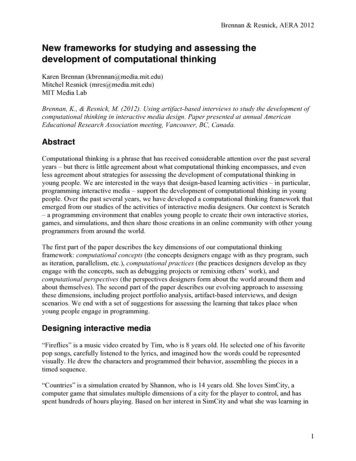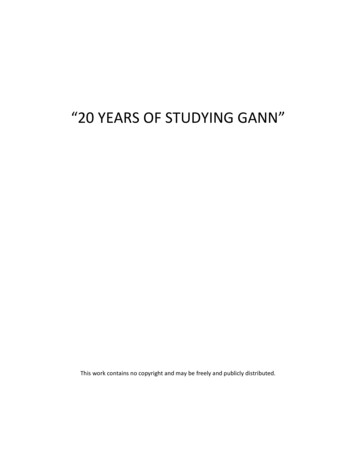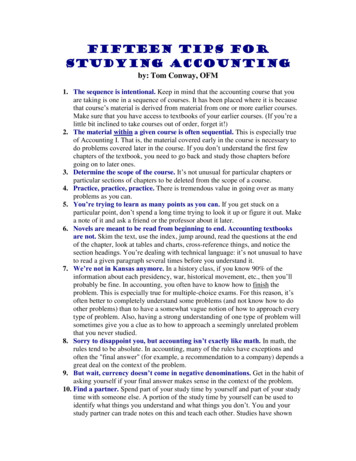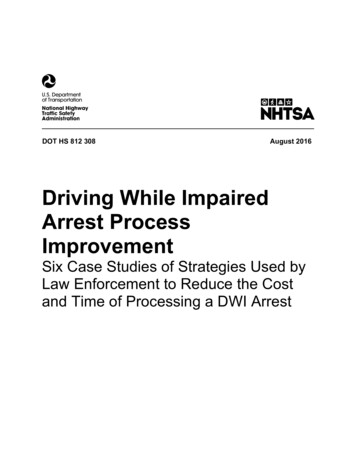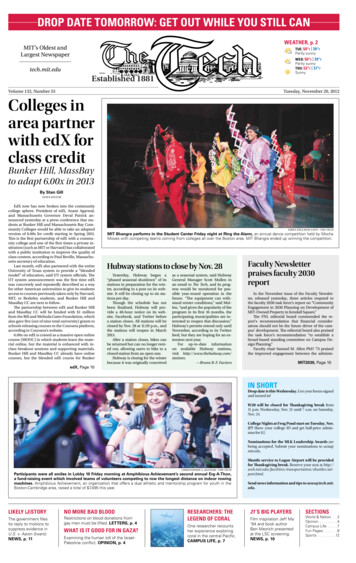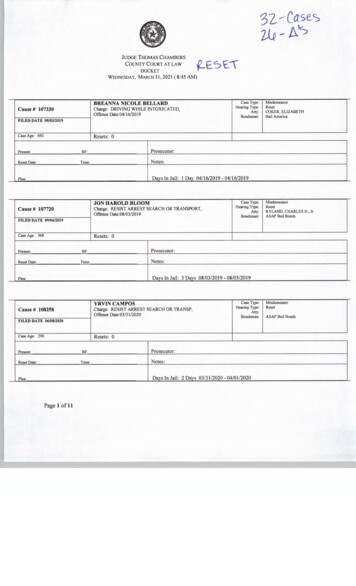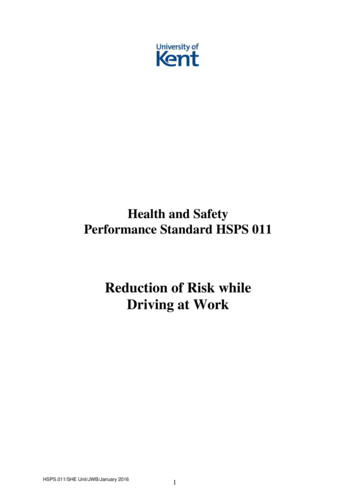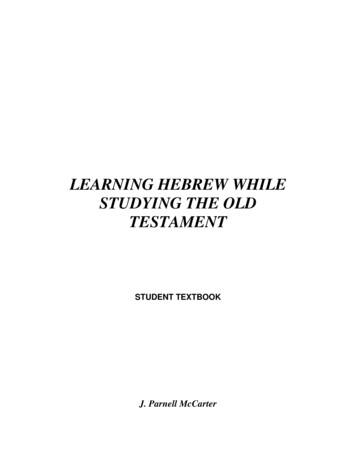
Transcription
LEARNING HEBREW WHILESTUDYING THE OLDTESTAMENTSTUDENT TEXTBOOKJ. Parnell McCarter
2006 J. Parnell McCarter. All Rights Reserved.6408 WrenwoodJenison, MI 49428(616) 457-8095The Puritans’ Home School Curriculumwww.puritans.netTHIRD EDITION2
INTRODUCTIONAfter students have completed the Sabbath Bible Survey Tests and Assignments of thePuritans’ Home School Curriculum, the Puritans’ Home School Curriculum provides thefollowing resources in the further pursuit of Bible education: LEARNING HEBREW WHILE STUDYING THE OLD TESTAMENT LEARNING GREEK WHILE STUDYING THE NEW TESTAMENTThere are certain aspects of the Bible one can more fully appreciate by a knowledge ofthe languages of the original. While these courses will not make students experts in theHebrew and Greek languages, they serve as a start.But as the titles suggest, the primary goal of these courses is the study of the Old andNew Testaments of the Bible, and learning some Hebrew and Greek are onlysupplemental goals. Indeed, the hope is that learning some Hebrew and Greek along theway will help in the study of the Bible. There will be much reading of the Bible inEnglish as part of this course, so as to make sure the primary end of the course is not lostas a result of a merely secondary goal.The resources of various websites have been utilized to compile this textbook. Theyinclude: http://www.ancient-hebrew.org/7 home.html (It provides the introductory lessonsin the first 13 assignments of this textbook.)http://www.blueletterbible.org/ (It provides the Hebrew text for each OldTestament Bible verse.)http://www.hebrewoldtestament.com/ (It provides the transliteration of theHebrew text for various Old Testament Bible verses.)http://foundationstone.com.au/ http://www.blueletterbible.org/ (It providessupplemental lesson information.)We encourage you to visit these websites to take full advantage of the resources theyoffer.After the completion of the first 13 assignments, students thereafter will be using thebook Biblical Hebrew: A Text and Workbook, by Bonnie Pedrotti Kittel, Vicki Hoffer,and Rebecca Abts Wright (Yale University Press: New Haven, 1989) for the remainingHebrew assignments. This can be purchased as a used book from Amazon.Com, as wellas other outlets. Make sure you are purchasing the First Edition.In this textbook edition we incorporate a survey of what are commonly called the majorand minor prophets of the Old Testament canon. These books will be surveyed, asstudents are also learning Hebrew. Hopefully by the end students can use their growingknowledge in Hebrew even in studying these Old Testament books.3
THE HEBREW ALPHABET:IN SCRIPT AND HANDWRITTEN FORM(Hebrew script is on the top line for each letter; Hebrew handwritten form is on thebottom.)4
ASSIGNMENT # 11. Over the coming assignments we shall survey the book of Isaiah. Here is howEaston’s Bible Dictionary introduces the book:Isaiah, The Book of - consists of prophecies delivered (Isa. 1) in the reign of Uzziah (15), (2) of Jotham (6), (3) Ahaz (7-14:28), (4) the first half of Hezekiah's reign (14:28-35),(5) the second half of Hezekiah's reign (36-66). Thus, counting from the fourth yearbefore Uzziah's death (B.C. 762) to the last year of Hezekiah (B.C. 698), Isaiah's ministryextended over a period of sixty-four years. He may, however, have survived Hezekiah,and may have perished in the way indicated above.The book, as a whole, has been divided into three main parts: (1.) The first thirty-fivechapters, almost wholly prophetic, Israel's enemy Assyria, present the Messiah as amighty Ruler and King. (2.) Four chapters are historical (36-39), relating to the times ofHezekiah. (3.) Prophetical (40-66), Israel's enemy Babylon, describing the Messiah as asuffering victim, meek and lowly.The genuineness of the section Isa. 40-66 has been keenly opposed by able critics. Theyassert that it must be the production of a deutero-Isaiah, who lived toward the close of theBabylonian captivity. This theory was originated by Koppe, a German writer at the closeof the last century. There are other portions of the book also (e.g., ch. 13; 24-27; andcertain verses in ch. 14 and 21) which they attribute to some other prophet than Isaiah.Thus they say that some five or seven, or even more, unknown prophets had a hand in theproduction of this book. The considerations which have led to such a result are various:(1.) They cannot, as some say, conceive it possible that Isaiah, living in B.C. 700, couldforetell the appearance and the exploits of a prince called Cyrus, who would set the Jewsfree from captivity one hundred and seventy years after. (2.) It is alleged that the prophettakes the time of the Captivity as his standpoint, and speaks of it as then present; and (3)that there is such a difference between the style and language of the closing section (4066) and those of the preceding chapters as to necessitate a different authorship, and leadto the conclusion that there were at least two Isaiahs. But even granting the fact of a greatdiversity of style and language, this will not necessitate the conclusion attempted to bedrawn from it. The diversity of subjects treated of and the peculiarities of the prophet'sposition at the time the prophecies were uttered will sufficiently account for this.The arguments in favour of the unity of the book are quite conclusive. When the LXX.version was made (about B.C. 250) the entire contents of the book were ascribed toIsaiah, the son of Amoz. It is not called in question, moreover, that in the time of ourLord the book existed in the form in which we now have it. Many prophecies in thedisputed portions are quoted in the New Testament as the words of Isaiah (Matt. 3:3;Luke 3:4-6; 4:16-41; John 12:38; Acts 8:28; Rom. 10:16-21). Universal and persistenttradition has ascribed the whole book to one author.5
Besides this, the internal evidence, the similarity in the language and style, in thethoughts and images and rhetorical ornaments, all points to the same conclusion; and itslocal colouring and allusions show that it is obviously of Palestinian origin. The theorytherefore of a double authorship of the book, much less of a manifold authorship, cannotbe maintained. The book, with all the diversity of its contents, is one, and is, we believe,the production of the great prophet whose name it bears.2. Read this assignment’s scripture reading in English: Isaiah chapters 1-3.3. Study this information about the Hebrew language.THE HEBREW ALEPHBETEnglish uses the word "Alphabet" which is the first two letters of the Greek Alphabet;Alpha and Beta. Hebrew on the other hand uses "Alephbet" as they are the first twoletters of the Hebrew Alephbet; Aleph and Bet. The Hebrew alephbet consists of 22consonants and no vowels. The vowels are dots and dashes added above and below theconsonants. One advantage to Hebrew is that the sound for each letter remains the same,unlike English where one has to memorize many variations such as the word circus whereone "c" is pronounced like an "S" and the other like a "K".DIRECTION OF READINGUnlike English which is read from left to right, Hebrew is read from right to left just asmany other semitic languages such as Arabic. This may sound difficult but in a very shorttime you will get used to it.When sounding out a word it will be easier if you remember the Consonant (C) andVowel (V) patterns. In English the consonants and vowels may be arranged in any ordersuch as in the word "circle" which has the following pattern; C-V-C-C-C-V. Hebrew onthe other hand is very consistent in that a vowel always follows a consonant (except thefinal consonant which may or may not be followed by a vowel), such as in the followingwords "Melek" (king) C-V-C-V-C; "Meleko" (his king) C-V-C-V-C-V and "Hamelek"(the king) C-V-C-V-C-V-C. The Yud (Y) is another exception to this as it can be aconsonant acting as a vowel, just as our English "Y".MODERN AND ANCIENT HEBREWThe pronunciation of some of the consonants and vowels have changed over thecenturies, but this does not affect the meaning of words, so we will learn to pronouncethem according to the modern Hebrew. Modern Hebrew pronunciation is also dividedinto two parts, Ashkenazie and Sephardic. Since Sephardic is the pronunciation adoptedby the State of Israel, we will also use this pronunciation.Below is the Hebrew Alphabet (you do not need to memorize it at this point):6
Here is the Hebrew alphabet in Hebrew handwritten form:3. Exercisesa. Write all the letters of the Hebrew alphabet in Hebrew handwritten form.b. Below is Genesis 1:1 in Hebrew (read right to left, then top to bottom):This is the Hebrew Transliterated form of Genesis 1:1 (read left to right):1:1 BUr'aShYTh BUr'a'aLHYM 'aTh HShMYM V'aTh H'aUrTSh.Write Genesis 1:1 in Hebrew handwritten form (write it here and elsewhere right to left) .c. Write a several sentence summary of the assignment’s scripture reading in English, andbe prepared to discuss the content of the scripture reading, along with the BibleDictionary information, with your teacher.7
ASSIGNMENT # 21. Read this assignment’s scripture reading in English: Isaiah chapters 4-8.2. Study this information about the Hebrew language.ConsonantsThe "aleph" is the first letter of the Hebrew alephbet (aka alphabet). Thisconsonant is silent.The "beyt" is pronounced two ways, a "b" as in ball, and as "v" as in visit. Adagesh (a dot in the middle of the letter) indicates that the letter will have the "b" sound,while the absence of the dagesh indicates the "v" sound. When the beyt is prefixed to aword it means "in".VowelsThis vowel, which is placed under the consonant, is pronounced "a" as in father.Since the aleph is silent, this consonant/vowel combination would be pronouncedas "a". (Note: The aleph here is not part of the vowel, it is simply used here to show theplacement of the vowel only)This vowel is also pronounced "a" as in father.3. Exercisesa. Practice saying the following Hebrew letters, and be prepared to say them to yourteacher:.1.28
b. Write the following in Hebrew handwritten form :.1.2c. Learn the following vocabulary words and write them in Hebrew handwritten form :VocabularyCame.1Father.2d. Practice saying the following sentence and write it in Hebrew handwritten form :SentencesFather Came.1e. Below is Isaiah 4:1 in Hebrew:Write Isaiah 4:1 in Hebrew handwritten form.f. Write a several sentence summary of the scripture reading in English, and be preparedto discuss the content of the scripture reading with your teacher.9
ASSIGNMENT # 31. Read this assignment’s scripture reading in English: Isaiah chapters 9-14.2. Study this information about the Hebrew language.ConsonantsThe "mem" is pronounced "m" as in mother.The"final mem" is the form of the letter used when at the end of a word. Thepronunciation does not change.The yud is pronounced "y" as in yes. When the yud is added at the end of a word itmeans "of me" or "my".VowelsThis vowel is pronounced "i" as in machine.This vowel is pronounced "e" as in grey.3. Exercisesa. Practice saying the following Hebrew letters, and be prepared to say them to yourteacher:Practice .1 .2 b. Write the following in Hebrew handwritten form :Practice 10.1
.2 c. Learn the following vocabulary words and write them in Hebrew handwritten form :VocabularyMother Who My mother My father .1 .2 .3 .4 d. Practice saying the following sentence and write it in Hebrew handwritten form :SentencesWho came? My father came. .1 .2 e. Below is Isaiah 9:1 in Hebrew:Write Isaiah 9:1 in Hebrew handwritten form.f. Write a several sentence summary of the scripture reading in English, and be preparedto discuss the content of the scripture reading with your teacher.11
ASSIGNMENT # 41. Read this assignment’s scripture reading in English: Isaiah chapters 15-19.2. Study this information about the Hebrew language.ConsonantsThe "nun" is pronounced "n" as in no.The"final nun" is the form of the letter used when at the end of a word. Thepronunciation does not change.The "hey" is pronounced "h" as in hello. When the "hey" is suffixed to the end of aword it makes the word feminine. When it is prefixed to the front of a word it isthe definite article meaning "the".Notes1. The English verb "to be" and its various tenses such as "am", "is" and "are" do notexist in Hebrew and need to be added in the translation.2. English has two indefinite articles, "a" and "an" which also do not exist in Hebrewand must be added in the translation.3. The vocabulary word below "ba'ah" is the feminine form of the masculine verb"ba'" (came) which was introduced in lesson 1.4. The final syllable of most Hebrew words is accented by pronouncing the finalConsonant-Vowel-Consonant as a syllable. For instance, the word for "I", in thevocabulary list below, is pronounced "a-niy" rather than an-iy.3. Exercisesa. Practice saying the following Hebrew letters, and be prepared to say them to yourteacher:Practice 12.1 .2 .3
b. Write the following in Hebrew handwritten form :Practice .1 .2 .3 c. Learn the following vocabulary words and write them in Hebrew handwritten form :VocabularyI Where Son She Prophet Came (f) What The .1 .2 .3 .4 .5 .6 .7 .8 d. Practice saying the following sentences and write them in Hebrew handwritten form :Where is my father? I am a father. 13.1 .2
Who is she? .3 e. Below is Isaiah chapter 15:1 in Hebrew:Write Isaiah chapter 15:1 in Hebrew handwritten form.f. Write a several sentence summary of the scripture reading in English, and be preparedto discuss the content of the scripture reading with your teacher.g. Translate the following English sentences into Hebrew:The prophet came. What is a prophet? My son came. 14
ASSIGNMENT # 51. Read this assignment’s scripture reading in English: Isaiah chapters 20-24.2. Study this information about the Hebrew language.ConsonantsThe "lamed" is pronounced "l" as in long. Wh
LEARNING HEBREW WHILE STUDYING THE OLD TESTAMENT LEARNING GREEK WHILE STUDYING THE NEW TESTAMENT There are certain aspects of the Bible one can more fully appreciate by a knowledge of the languages of the original. While these courses will not make students experts in the Hebrew and Greek languages, they serve as a start. But as the titles suggest, the primary goal of

